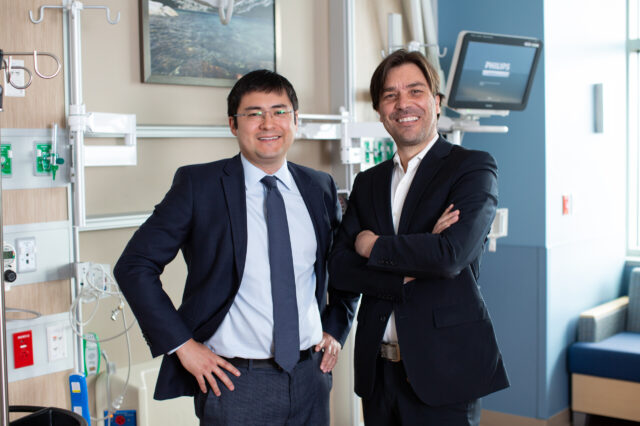Lung patients expected to see benefits as UF Health ramps up specialty intensive care unit

Lung patients in the region may soon be able to breathe easier, literally. University of Florida Health is ramping up its new thoracic and vascular intensive care unit, which surgeons say will benefit lung transplant and other pulmonary patients.
The new ICU began treating small numbers of patients earlier this year. Some other beds will be opened in mid-August, and by October, all 24 beds will be available. The unit, located in the UF Health Heart & Vascular Hospital, provides many advantages for patients. In particular, patients recovering from lung transplants and those needing artificial lung support are now grouped together with their caregivers close by.
“Putting all our patients together is a way to optimize resources so that a strong team of people can provide the very best lung care,” said Tiago Machuca, M.D., Ph.D., surgical director of the Lung Transplant Program and an associate professor of surgery in the UF College of Medicine.
A specialized ICU gives lung patients advantages that they wouldn’t have in a general ICU, such as the opportunity to walk about while receiving support from an artificial-lung machine or getting out of bed the day after a lung transplant. Meanwhile, respiratory therapists, nurses, pulmonary physicians and surgeons are close at hand. Before the new unit opened, lung patients were dispersed in adult or pediatric ICUs, as were those who treated them. Now, procedures, recovery and follow-up visits all happen in the same location.
“Bringing all these disciplines together allows patients to have early mobilization after a procedure and aggressive physical therapy while they are dealing with their recovery,” said Andres Pelaez, M.D., the medical director of the Lung Transplant Program and an associate professor of medicine in the UF College of Medicine.
The unit’s thoughtful design also has other patient-centered benefits: Sunlight streams in through large windows. Rooms are more spacious, giving family members a place to stay overnight with patients. More space also means multiple life support devices can be brought in without overwhelming the room.
“These are patients who are very isolated and often in pain,” Pelaez said. “If they don’t have access to family members and light and a view of the outside world, their recovery becomes harder.”
The new ICU comes as UF Health’s lung programs continue to grow in stature and volume. Today, UF Health ranks first in Florida and 13th nationally in lung transplant volume. First-year patient survival has jumped to 92.4 percent from 74.3 percent in 2014. Among 12 lung programs in 10 southeastern states, surgeons at UF Health performed the second-most transplants and had the second-lowest mortality rate among adults awaiting a transplant between July 2015 and June 2017.
Beyond the numbers, Pelaez and Machuca said UF Health is at the forefront of innovative care that allows more lung transplants to happen. Lung donors are often taller men who have suffered a traumatic injury, meaning their lungs aren’t a perfect match for some women. UF Health is one of only a handful of hospitals in the country that resize donor lungs, Machuca said. That helps reduce the waiting time for smaller patients.
“We are taking larger lungs and tailoring them to the recipients’ needs,” said Machuca.
Machuca said he is similarly proud of other lung program accomplishments, including setting up an artificial lung program for adults in 2015. It uses a device known as extracorporeal membrane oxygenation, or ECMO. It oxygenates the blood while removing carbon dioxide, functioning as an external lung that allows a patient to recover from a lung injury. Machuca said ECMO is one reason the lung transplant program has been increasingly busy and successful: Transplant patients often need to have ECMO treatment while waiting for new donor lungs.
Other technology has allowed UF Health to improve the viability of many donated lungs, allowing more of them to be used and reducing transplant patients’ wait time. The XVIVO Lung Perfusion System allows donor lungs to be kept alive and potentially improved to become eligible for transplant. About 80 percent of donor lungs are initially deemed unsuitable for transplant but some of those problems, such as impaired gas exchange or pulmonary edema, can be reversed. The XVIVO system pumps oxygen and a preservative into the lungs, allowing transplant surgeons to observe them over time. UF Health has used the XVIVO system since early 2015.
But even the best technology needs a focused team to improve outcomes, Machuca said. A dedicated team of nurses, physical therapists, social workers and physicians can help boost a high-risk patient’s chances of becoming a viable transplant candidate. Likewise, he credits the UF Health administration’s commitment to improving the lung transplant program.
“I’m extremely proud of where we are today. We have become a high-volume program with excellent outcomes. It’s due to a lot of hard work by a lot of people,” Machuca said.
About the author
